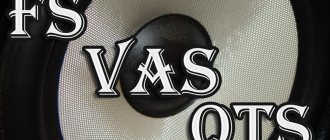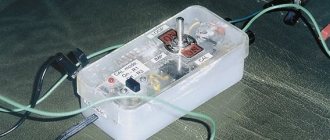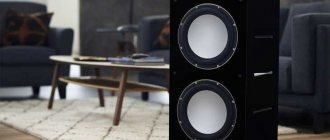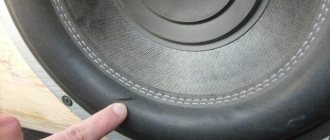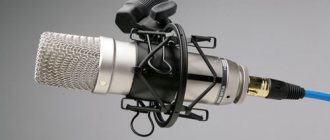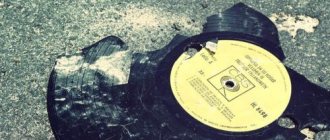So I decided to write an article myself, which is very important for acousticians. In this article I want to describe ways to measure the most important parameters of dynamic heads - the Thiel-Small parameters.
Remember! The following method for measuring Thiel-Small parameters at home is only effective for measuring Thiel-Small parameters of speakers with resonant frequencies below 100 Hz (i.e., woofers); at higher frequencies the error increases.
The most basic Thiel-Small parameters, which can be used to calculate and manufacture an acoustic design (in other words, a box) are:
- Speaker Resonance Frequency Fs (Hertz)
- Equivalent volume Vas (liters or cubic feet)
- Full quality Qts
- DC resistance Re (Ohm)
For a more serious approach, you will also need to know:
- Mechanical quality factor Qms
- Electrical quality factor Qes
- Diffuser area Sd (m2) or diameter Dia (cm)
- Sensitivity SPL (dB)
- Inductance Le (Henry)
- Impedance Z (Ohm)
- Peak power Pe (Watt)
- Mass of the moving system Mms (g)
- Relative stiffness (mechanical flexibility) Cms (meters/newton)
- Mechanical resistance Rms (kg/sec)
- Motor power (product of induction in the magnetic gap by the length of the voice coil wire) BL (Tesla*m)
Most Thiel-Small parameters can be measured or calculated at home using not particularly sophisticated measuring instruments and a computer or calculator that can extract roots and exponentiate. For an even more serious approach to designing acoustic design and taking into account the characteristics of speakers, I recommend reading more serious literature.
The author of this “work” does not claim any special knowledge in the field of theory, and everything presented here is a compilation from various sources - both foreign and Russian.
Measurement of Thiel-Small parameters Re, Fs, Fc, Qes, Qms, Qts, Qtc, Vas, Cms, Sd, Mms.
To carry out Thiel-Small measurements you will need the following equipment:
- Voltmeter.
- Audio frequency signal generator. Generator programs that generate the necessary frequencies are suitable. Like Marchand Function Generator or NCH tone generator. Since it is not always possible to find a frequency meter at home, you can completely trust these programs and your sound card installed on your computer.
- Powerful (at least 5 watts) resistor with a resistance of 1000 ohms.
- Accurate (+- 1%) 10 ohm resistor.
- Wires, clamps and other rubbish to connect it all into a single circuit.
Rice. 1. Scheme for measuring Thiel-Small parameters
SECOND MAP, NOT MEASURED IN ANYTHING
The brake power of a speaker is numerically expressed in the second Thiel-Small parameter. This is the total quality factor of the speaker, designated Qts. Expressed numerically, but not literally. I mean, the more powerful the brakes, the lower the Qts value. Hence the name “quality factor” in Russian (or quality factor in English, from which the designation of this quantity originated), which is, as it were, an assessment of the quality of the oscillatory system. Physically, the quality factor is the ratio of elastic forces in a system to viscous forces, otherwise - to friction forces. Elastic forces store energy in the system, alternately transferring energy from potential (a compressed or stretched spring or speaker suspension) to kinetic (the energy of a moving diffuser). Viscous ones strive to turn the energy of any movement into heat and irrevocably dissipate. A high quality factor (and for the same bell it will be measured in tens of thousands) means that there are much more elastic forces than frictional forces (viscous, these are the same thing). This also means that for each oscillation only a small part of the energy stored in the system will be converted into heat. Therefore, by the way, quality factor is the only value in the three Thiel-Small parameters that does not have a dimension; it is the ratio of one force to another. How does a bell dissipate energy? Through internal friction in bronze, mainly slowly. How does a speaker do this, whose quality factor is much lower, and therefore the rate of energy loss is much higher? In two ways, depending on the number of “brakes”. Part is dissipated through internal losses in the elastic elements of the suspension, and this share of losses can be estimated by a separate value of the quality factor, it is called mechanical, denoted Qms. The second, larger part is dissipated in the form of heat from the current passing through the voice coil. The current produced by her. This is the electrical quality factor Qes. The total effect of the brakes would be determined very easily if it were not the values of the quality factor, but, on the contrary, the values of losses that were used. We would just fold them. And since we are dealing with quantities that are the reciprocals of losses, then we will have to add the reciprocal quantities, which is why it turns out that 1/Qts = 1/Qms + 1/Qes.
Typical values of quality factor: mechanical - from 5 to 10. Electrical - from 0.2 to 1. Since inverse values are involved, it turns out that we sum up the mechanical contribution to losses of the order of 0.1 - 0.2 with the electrical contribution, which is from 1 to 5. It is clear that the result will be determined mainly by the electrical quality factor, that is, the main brake of the speaker is electric.
So how do you snatch the names of the “three cards” from the speaker? Well, at least the first two, we'll get to the third. It is useless to threaten with a pistol, like Hermann, the speaker is not an old woman. The same voice coil, the fiery speaker motor, comes to the rescue. After all, we have already realized: a flame motor also works as a flame generator. And in this capacity, it seems to be sneaking about the amplitude of vibrations of the diffuser. The greater the voltage appears on the voice coil as a result of its oscillations together with the diffuser, the greater the range of oscillations, which means the closer we are to the resonant frequency.
How to measure this voltage, given that a signal from the amplifier is connected to the voice coil? That is, how to separate what is supplied to the motor from what is generated by the generator, is it on the same terminals? You don’t need to divide, you need to measure the resulting amount.
This is why they do this. The speaker is connected to an amplifier with the highest possible output impedance; in real life, this means: a resistor with a value of much, one hundred, at least, times the nominal resistance of the speaker is connected in series with the speaker. Let's say 1000 ohms. Now, when the speaker is operating, the voice coil will generate a back-EMF, sort of like for the operation of an electric brake, but braking will not occur: the coil leads are closed to each other through a very high resistance, the current is negligible, the brake is useless. But the voltage, according to Lenz’s rule, is opposite in polarity to the supplied one (“generating movement”), will be in antiphase with it, and if at this moment you measure the apparent resistance of the voice coil, it will seem that it is very large. In fact, in this case, the back-EMF does not allow the current from the amplifier to flow unhindered through the coil, the device interprets this as increased resistance, but what else?
By measuring the impedance, that very “apparent” (but in fact complex, with all sorts of active and reactive components, now is not the time to talk about that) resistance, two cards out of three are revealed. The impedance curve of any cone speaker, from Kellogg and Rice to the present day, looks, in principle, the same, it even appears in the logo of some electroacoustic scientific community, I forget which one now. The hump at low (for this speaker) frequencies indicates the frequency of its fundamental resonance. Where there is a maximum, there is the coveted Fs. It couldn't be more elementary. Above resonance there is a minimum impedance, which is usually taken as the nominal impedance of the speaker, although, as you can see, it remains this way only in a small frequency band. Higher up, the total resistance begins to increase again, now due to the fact that the voice coil is not only a motor, but also an inductance, the resistance of which increases with frequency. But we won’t go there now; the parameters that interest us don’t live there.
It is much more complicated with the value of the quality factor, but, nevertheless, comprehensive information about the “second card” is also contained in the impedance curve. Comprehensive, because from one curve you can calculate both the electrical Qes and the mechanical quality factor Qms, separately. We already know how to then make a complete Qts out of them, which is really necessary when calculating the design; it’s a simple matter, not a Newton binomial.
We will discuss exactly how the required values are determined from the impedance curve another time, when we talk about methods for measuring parameters. Now we will assume that someone (the speaker manufacturer or the associates of your humble servant) did this for you. But I will note this. There are two misconceptions associated with attempts to expressly analyze the Thiel-Small parameters based on the shape of the impedance curve. The first is completely bogus, and we will now dispel it without a trace. This is when they look at the impedance curve with a huge hump at resonance and exclaim: “Wow, good quality!” Kind of high. And looking at the small bump on the curve, they conclude: since the impedance peak is so smooth, it means that the speaker has high damping, that is, a low quality factor.
So: in the simplest version, it’s exactly the opposite. What does a high impedance peak at resonance frequency mean? That the voice coil produces a lot of back-EMF, designed to electrically brake the oscillations of the cone. Only with this connection, through a large resistance, the current necessary for the operation of the brake does not flow. And when such a speaker is turned on not for measurements, but normally, directly from the amplifier, the braking current will flow, be healthy, the coil will become a powerful obstacle to the excessive oscillations of the diffuser at its favorite frequency.
All other things being equal, you can roughly estimate the quality factor from the curve, and remembering: the height of the impedance peak characterizes the potential of the speaker's electric brake, therefore, the higher it is, the LOWER the quality factor. Will such an assessment be exhaustive? Not exactly, as was said, she will remain rude. Indeed, in the impedance curve, as already mentioned, information about both Qes and Qms is buried, which can be dug out (manually or using a computer program) by analyzing not only the height, but also the “shoulder width” of the resonant hump. In this regard, we have carried out several computational experiments here; if you are interested, take a look.
And how does the quality factor affect the shape of the speaker’s frequency response? This is what interests us, isn’t it? How it affects - it has a decisive impact. The lower the quality factor, that is, the more powerful the internal brakes of the speaker at the resonant frequency, the lower and more smoothly the curve will pass near the resonance, characterizing the sound pressure created by the speaker. The minimum ripple in this frequency band will be at Qts equal to 0.707, which is commonly called the Butterworth characteristic. At high Q values, the sound pressure curve will begin to “hump” near resonance, it’s clear why: the brakes are weak.
Is there a “good” or a “bad” total quality factor? By itself, no, because when the speaker is installed in an acoustic design, which we will now consider only a closed box, both its resonance frequency and overall quality factor will become different. Why? Because both depend on the elasticity of the speaker suspension. The resonant frequency depends only on the mass of the moving system and the rigidity of the suspension. As stiffness increases, Fs increases, and as mass increases, it decreases. When the speaker is installed in a closed box, the air in it, which has elasticity, begins to act as an additional spring in the suspension, the overall rigidity increases, Fs increases. The total quality factor also increases, since it is the ratio of elastic forces to braking forces. The brake capabilities of the speaker will not change from installing it to a certain volume (why would it?), but the total elasticity will increase, the quality factor will inevitably increase. And it will never become lower than the “naked” dynamics. Never, this is the lower limit. How much will all this increase? And this depends on how rigid the speaker’s own suspension is. Look: the same value of Fs can be obtained with a light diffuser on a soft suspension or with a heavy one on a hard suspension; mass and stiffness act in opposite directions, and the result may turn out to be numerically equal. Now if we place a speaker with a rigid suspension in some volume (which has the elasticity required for this volume), then it will not notice a slight increase in the total stiffness, the values of Fs and Qts will not change much. Let’s put a speaker with a soft suspension there, in comparison with the stiffness of which the “air spring” will already be significant, and we will see that the total stiffness has changed significantly, which means that Fs and Qts, initially the same as those of the first speaker, will change significantly.
In the dark “pre-Tile” times, in order to calculate new values of the resonance frequency and quality factor (they, in order not to be confused with the parameters of the “bare” speaker, are designated as Fc and Qtc), it was necessary to know (or measure) directly the elasticity of the suspension, in millimeters per newton of applied force , know the mass of the moving system, and then play tricks with calculation programs. Thiel proposed the concept of “equivalent volume,” that is, a volume of air in a closed box whose elasticity is equal to the elasticity of the speaker suspension. This value, designated Vas, is the third magic card.
Calibration:
First you need to calibrate the voltmeter. To do this, instead of a speaker, a 10 Ohm resistance is connected and by selecting the voltage supplied by the generator, it is necessary to achieve a voltage of 0.01 volts. If the resistor is of a different value, then the voltage should correspond to 1/1000 of the resistance value in Ohms. For example, for a 4 ohm calibration resistance, the voltage should be 0.004 volts.
Remember! After calibration, the generator output voltage cannot be adjusted until all measurements are completed.
Finding the resonant frequency of the speaker Fs and Rmax
The speaker during this and all subsequent measurements must be in free space. The resonant frequency of a speaker is found at the peak of its impedance (Z-characteristic). To find it, smoothly change the frequency of the generator and look at the voltmeter readings.
The frequency at which the voltage Us on the voltmeter will be maximum (a further change in frequency will lead to a voltage drop) will be the main resonance frequency Fs for this speaker. For speakers with a diameter greater than 16 cm, this frequency should be below 100 Hz.
Don't forget to record not only the frequency Fs, but also the voltmeter readings Us.
Multiplied by 1000, they will give the speaker resistance at the resonant frequency Rmax, necessary for calculating other parameters.
TO HANG OR NOT TO HANG?
The figurative definition of the conditions for measuring Fs as the resonant frequency of a speaker hanging in the air gave rise to the misconception that this is how this frequency should be measured, and enthusiasts actually tried to hang speakers on wires and ropes. A separate issue of “BB”, or even more than one, will be devoted to measuring acoustic parameters, but I’ll note here: in competent laboratories, speakers are clamped in a vice during measurements, and not suspended from a chandelier.
The results of a computational experiment that will help those wishing to understand how the values of electrical and mechanical quality factor are expressed in impedance curves. We took the full set of electromechanical parameters of a real-life speaker, and then began to change some of them. First, the mechanical quality, as if the material of the corrugation and the centering washer had been replaced. Then - electric, for this it was necessary to change the characteristics of the drive and the moving system. Here's what happened:
Real impedance curve of a woofer. It calculates two of the three main parameters
Impedance curves for different values of the total quality factor, while the electrical Qes is the same, equal to 0.5, and the mechanical one varies from 1 to 8. The total quality factor Qts does not seem to change much, but the height of the hump on the impedance graph changes greatly and very , while the lower the Qms, the sharper it becomes
Dependence of sound pressure on frequency at the same Qts values. When measuring sound pressure, only the total quality factor Qts is important, so completely different impedance curves correspond to not so different sound pressure curves versus frequency
The same Qts values, but now Qms = 4 everywhere, and Qes changes so as to reach the same Qts values. The Qts values are the same, but the curves are completely different and differ much less from each other. The lower, red curves were obtained for those values that could not be obtained in the first experiment at a fixed Qes = 0.5
Sound pressure curves for different Qts obtained by changing Qes. The four upper curves are exactly the same in shape as when we changed Qms, their shape is determined by the Qts values, but they remain the same. The lower, red curves obtained for Qts greater than 0.5 are, of course, different, and a hump begins to grow on them due to the increased quality factor.
Now pay attention: the point is not only that at high Qts a hump appears on the characteristic, and the sensitivity of the speaker at frequencies above the resonant one decreases. The explanation is simple: other things being equal, Qes can only increase with an increase in the mass of the moving system or with a decrease in the magnet power. Both lead to a decrease in sensitivity at mid frequencies. So the hump at the resonant frequency is, rather, a consequence of the dip at frequencies above the resonant one. There is nothing free in acoustics...
Finding Qms, Qes and Qts
These parameters are found using the following formulas:
Rice. 2. Formulas for measuring Thiel-Small parameters
As you can see, this is a sequential finding of additional parameters Ro, Rx and measurement of previously unknown frequencies F1 and F2.
Rice. 3. Graph of DC resistance versus resonant frequency
These are the frequencies at which the speaker impedance is equal to Rx. Since Rx is always less than Rmax, there will be two frequencies - one is slightly less than Fs, and the other is slightly more.
The frequencies F1 and F2 are determined below and above the resonant frequency Fs, at which the voltage at the head terminals takes on a certain value U1.2, less than Us. For example, U1,2 = 0.7 Us. You can check the accuracy of your measurements with the following formula:
Rice. 4. Formula for calculating the resonant frequency of the speaker
If the calculated result differs from the previously found one by more than 1 hertz, then you need to repeat everything all over again and more carefully. So, we have found and calculated several basic parameters and can draw some conclusions based on them:
- If the resonant frequency of the speaker is above 50 Hz, then it has the right to claim to work, at best, as a midbass. You can immediately forget about the subwoofer on such a speaker.
- If the resonant frequency of the speaker is above 100 Hz, then it is not a woofer at all. You can use it to reproduce mid frequencies in three-way systems.
- If a speaker's Fs/Qts ratio is less than 50, then that speaker is designed to operate exclusively in closed boxes. If more than 100 - exclusively for working with a bass reflex or in bandpasses. If the value is between 50 and 100, then you need to carefully look at other parameters - what type of acoustic design the speaker gravitates towards. It is best to use special computer programs for this that can graphically simulate the acoustic output of such a speaker in different acoustic designs. True, you cannot do without other, no less important parameters - Vas, Sd, Cms and L.
Measurement and calculation of Thiel-Small parameters
The most basic parameters of a dynamic head, which can be used to calculate and produce an acoustic design (in other words, a box) are:
- resonant frequency Fs (Hz)
- equivalent volume Vas (l)
- full quality factor Qts
- DC resistance Re (Ohm)
For a more serious approach you will need:
- mechanical quality factor Qms
- electrical quality factor Qes
- diffuser area Sd (m2) or its diameter D (cm)
- sensitivity SPL (dB)
- inductance Le (H)
- impedance Z (Ohm)
- peak power Pe (W)
- mass of mobile system Mms (g)
- relative hardness Cms (meters/newton)
- mechanical resistance Rms (kg/sec)
- motor power BL
The main measurement is finding the Z-curve at the resonance frequency, which can be measured by assembling the following equipment:
- voltmeter;
- audio frequency signal generator;
- powerful (5 W) resistor with a resistance of 1 kOhm;
- precise (±1%) 10 ohm resistor;
Most generators have their own frequency scale, but if there is none, then you will also need a frequency meter connected in parallel at the output of the generator. Instead of a generator, you can use a computer sound card and a program with a generator .
Let's assemble the diagram:
First you need to calibrate the voltmeter. To do this, instead of the speaker, a resistance of 10 Ohms is connected and by selecting the voltage supplied by the generator, it is necessary to achieve a voltage of 0.01 V. If the resistor is of a different value, then the voltage should correspond to 1/1000 of the resistance value in [Ohm]. For example, for a calibration resistance of 4 Ohms, the voltage should be 0.004 V. After calibration, the output voltage of the generator CANNOT be adjusted until all measurements are completed. During this and all subsequent measurements, the speaker being measured must be in free space.
Re – speaker DC resistance (Ohm)
By connecting a speaker instead of a calibration resistance and setting the frequency on the generator to close to 0 Hz, we can determine its resistance to direct current - Re. It will be the voltmeter reading multiplied by 1000. However, Re can be measured directly with an ohmmeter.
Fs – main resonance frequency (Hz)
The resonant frequency of a speaker is found at the peak of its impedance (Z-characteristic). To find it, smoothly change the frequency of the generator and look at the voltmeter readings. The frequency at which the voltage on the voltmeter will be maximum (a further change in frequency will lead to a voltage drop) will be the main resonance frequency for this speaker. The voltmeter reading multiplied by 1000 will give the speaker resistance at the resonant frequency Rmax . Once you have a similar impedance curve, you can calculate the remaining parameters.
Ro and Rx – intermediate resistances for subsequent calculations (Ohm)
Rx is an important parameter; it can be calculated using two formulas. In any case, the Rx should be the same:
Rmax – maximum resistance (resistance at the resonance frequency); Re – speaker resistance (measured with an accurate tester or at a frequency of 0 Hz).
Qms – mechanical quality factor
Fs – frequency of the main resonance, found earlier; Ro – intermediate resistance, found earlier. F1 – the first frequency on the Z-curve according to the Rx level; F2 is the second frequency on the Z-curve in terms of Rx level.
The frequencies F1 and F2 are the frequencies at which the speaker impedance is equal to Rx . Since Rx is always less than Rmax , then there will be two frequencies - one less than Fs , and the other more. You can check the calculation results using the following formula:
If the calculated result differs from the previously found one by more than 1 Hz, then you need to repeat everything all over again and more carefully.
Qes – electrical quality factor
Qts – total quality factor
We found and calculated the main parameters from which we can draw some conclusions:
- If the resonant frequency of the speaker is above 50 Hz, then it has the right to claim to work, at best, as a midbass. You can immediately forget about the subwoofer on such a speaker.
- If the resonant frequency of the speaker is above 100 Hz, then it is not a woofer at all. You can use it to reproduce mid frequencies in three-way systems.
- If Fs/Qts is less than 50, then that speaker is designed to operate exclusively in closed boxes. If more than 100 - exclusively for working with a bass reflex or in bandpasses. If the value is between 50 and 100, then you need to carefully look at other parameters - what type of acoustic design the speaker gravitates towards. It is best to use special computer programs for this that can graphically simulate the acoustic output of such a speaker in different acoustic designs. , you cannot do without other, no less important parameters - Vas, Sd, Cms and L.
Sd – effective radiating surface of the diffuser (m2)
P – the number “pi” is a mathematical constant equal to 3.14; r – radius, in this case half the distance from the middle of the width of the rubber suspension on one side to the middle of the rubber suspension on the opposite side. This is due to the fact that half the width of the rubber suspension is also a radiating surface. Please note that the unit of measurement for this area is square meters. Accordingly, the radius must be substituted into it in meters.
L – speaker coil inductance (H)
To do this, you need the results of one of the readings from the very first test. You will need an impedance (impedance) of the voice coil at a frequency of about 1000 Hz. Since the reactive component ( XL ) is separated from the active Re by an angle of 90°, we can use the Pythagorean theorem:
Since Z (coil impedance at a certain frequency) and Re (coil DC resistance) are known, the formula converts to:
Z – speaker impedance at a frequency of 1000 Hz; Re – speaker resistance (measured with an accurate tester or at a frequency of 0 Hz).
Having found the reactance XL at frequency F , you can calculate the inductance itself using the formula:
XL – reactance found in the previous formula; P – the number “pi” is a mathematical constant equal to 3.14; F is the frequency at which we determine the inductance, usually 1000 Hz.
Vas – equivalent volume
At home, it is easier to use two methods for determining the equivalent volume of dynamism: the “additional mass” method and the “additional volume” method. The first of them requires several weights of known weight from materials. You can use a set of weights from pharmacy scales or use old copper coins of 1,2,3 and 5 kopecks, since the weight of such a coin in grams corresponds to the face value. The second method requires a sealed box of a predetermined volume with a corresponding hole for the speaker.
Vas – added mass method
First you need to evenly load the diffuser with a load and measure its resonant frequency again, writing it down as F's. It should be lower than Fs. It is better if the new resonant frequency is 30-50% less. The weight is approximately 10 grams per inch of diffuser diameter. Those. for a 12″ head you need a load weighing about 120 grams.
Cms – relative stiffness based on the results obtained:
P – the number “pi” is a mathematical constant equal to 3.14; Fs – resonant frequency without design, calculated above (Hz); F’s – resonant frequency without registration with load (Hz); M – weight in cargo (kg).
Based on the results obtained, Vas is calculated using the formula (m3):
Vas – additional volume method
To do this, you will need a sealed closed box with the required hole for the speaker being measured. We attach the speaker with the magnet facing outwards. The volume of the box is designated as Vb . Then you need to measure Fc (the resonant frequency of the speaker in a closed box) and, accordingly, calculate Qmc, Qec and Qtc . The measurement technique is completely similar to the dynamics described above without design; we draw the same Z-curve. Then the equivalent volume is found using the formula:
Vb – volume of a closed box; Fc – resonant frequency of the speaker in the box; Qec – electrical quality factor of the speaker in the box; Fs – resonant frequency of the speaker without design; Qes – electrical quality factor of the speaker without design.
You can use a simpler formula with almost the same results:
Vb – volume of a closed box; Fc – resonant frequency of the speaker in the box; Fs – resonant frequency of the speaker without design;
The data obtained as a result of all these measurements is sufficient for further calculation of the acoustic design of a low-frequency link of a sufficiently high class. The above technique is effective only for measuring the parameters of speakers with resonant frequencies below 100 Hz; at higher frequencies the error increases.
Based on materials from: cxem.net
Finding the diffuser surface area Sd
This is the so-called effective radiating surface of the diffuser. For the lowest frequencies (in the zone of piston action) it coincides with the design one and is equal to:
Rice. 5. Formula for calculating diffuser surface area
The radius R in this case will be half the distance from the middle of the width of the rubber suspension on one side to the middle of the rubber suspension on the opposite side. This is due to the fact that half the width of the rubber suspension is also a radiating surface. Please note that the unit of measurement for this area is square meters. Accordingly, the radius must be substituted into it in meters.
Finding the inductance of the speaker coil L
To do this, you need the results of one of the readings from the very first test. You will need an impedance (impedance) of the voice coil at a frequency of about 1000 Hz. Since the reactive component (XL) is separated from the active Re by an angle of 900, we can use the Pythagorean theorem:
Rice. 6. Formula for coil impedance at a certain frequency
Since Z (coil impedance at a certain frequency) and Re (coil DC resistance) are known, the formula converts to:
Rice. 7. Formula for coil impedance at a certain frequency
Having found the reactance XL at frequency F, you can calculate the inductance itself using the formula:
Rice. 8. Coil inductance formula
CARD THIRD, VOLUMERIAN
How Vas is measured is a separate story, there are funny twists, and this, as I’m saying for the third time, will be in a special issue of the series. For practice, it is important to understand two things. First: an extremely Lokhov’s misconception (alas, it still occurs) that the Vas value given in the accompanying documents for the speaker is the volume in which the speaker should be placed. And this is just a characteristic of the speaker, depending only on two quantities: the rigidity of the suspension and the diameter of the diffuser. If you put a speaker in a box with a volume equal to Vas, the resonant frequency and overall quality factor will increase by a factor of 1.4 (this is the square root of two). If in a volume equal to half Vas - 1.7 times (root of three). If you make a box with a volume of one third of Vas, everything else will double (the root of four, the logic should already be clear without formulas).
As a result, indeed, the smaller, other things being equal, the Vas value of the speaker, the more compact design you can count on, while maintaining the planned indicators for Fc and Qtc. Compactness, however, does not come for free. There is no such thing as free in acoustics. The low Vas value at the same resonant frequency of the speaker is the result of a combination of a rigid suspension with a heavy moving system. And the sensitivity most decisively depends on the mass of the “movement”. Therefore, all subwoofer heads, distinguished by the ability to operate in compact closed enclosures, are also characterized by low sensitivity compared to colleagues with lightweight diffusers but high Vas values. So there are no good or bad Vas values either, everything has its own price.
What will we talk about next time? It’s clear what we’re talking about. We know the cards, now we know how to deal them, which ones to use...
Tags: Neville ThielRichard Small
Measurement of equivalent volume Vas
There are several ways to measure equivalent volume, but at home it is easier to use two: the “additional mass” method and the “additional volume” method.
The first of them requires several weights of known weight from materials. You can use a set of weights from pharmacy scales or use old copper coins of 1,2,3 and 5 kopecks, since the weight of such a coin in grams corresponds to the face value.
The second method requires a sealed box of a predetermined volume with a corresponding hole for the speaker.
Finding Vas using the added mass method
First you need to evenly load the diffuser with weights and measure its resonant frequency again, writing it down as F's. It should be lower than Fs. It is better if the new resonant frequency is 30% -50% less. The weights are approximately 10 grams per inch of diffuser diameter. Those. for a 12″ head you need a load weighing about 120 grams.
Then you need to calculate Cms based on the results obtained using the formula:
Rice. 9. Formula for calculating relative stiffness
where M is the mass of added weights in kilograms.
Based on the results obtained, Vas(m3) is calculated using the formula:
Rice. 9. Formula for calculating equivalent volume
Finding Vas using the additional volume method
It is necessary to seal the speaker in the measuring box. It is best to do this with the magnet facing out, since the speaker does not care which side it has volume on, and it will be easier for you to connect the wires. And there are fewer extra holes. The volume of the box is designated as Vb.
Then you need to measure Fc (the resonant frequency of the speaker in a closed box) and, accordingly, calculate Qmc, Qec and Qtc. The measurement technique is completely similar to that described above. Then the equivalent volume is found using the formula:
Rice. 10. Formula for calculating equivalent volume using the additional volume method
The data obtained as a result of all these measurements is sufficient for further calculation of the acoustic design of a low-frequency link of a sufficiently high class. But how it is calculated is a completely different story.
CONTRIBUTION OF THE JUNIOR PARTNER
By the way: the founder of the method A.N. Thiel intended to take into account only the electrical quality factor in the calculations, believing (correctly for his time) that the share of mechanical losses was negligible compared to the losses caused by the operation of the “electric brake” of the speaker. The junior partner's contribution, however, was not the only one, however, was taking into account Qms, this has now become important: modern drivers use materials with increased losses that did not exist in the early 60s, and we came across speakers where the Qms value was only 2 - 3, with electric under unit. In such cases, it would be a mistake not to take mechanical losses into account. And this became especially important with the introduction of ferrofluid cooling in RF heads, where, due to the damping effect of the liquid, the Qms share in the total quality factor becomes decisive, and the impedance peak at the resonance frequency becomes almost invisible, as in the first graph of our computational experiment.

